July 14, 2017
Air Date: July 14, 2017
FULL SHOW
SEGMENTS

Top Gear for the Electric Car
View the page for this story
European nations and marquee car brands are setting a fast pace to electrify personal transport. For an overview of the electric and hybrid car revolution, Living on Earth Host Steve Curwood called on CarTalk blogger and green car journalist Jim Motavalli to explain what’s in play and how electric vehicles will benefit the planet. (10:30)

Warning About Antimicrobial Triclosan
View the page for this story
Two hundred scientists and health professionals signed a statement calling for more caution in using triclosan and triclocarbon. These common antibacterials are in thousands of products from building materials to toothpaste, and impact hormonal systems in animals. Brian Bienkowski, editor at Environmental Health News, and host Steve Curwood discuss why there may be a need for caution. (06:30)

Obesity and House Dust
View the page for this story
Certain hormones at times tell our bodies whether or not to create fat cells, and hormone disrupting chemicals can confuse those messages. Such chemicals are found in chemicals such as pesticides, flame retardants, and plastics. They also turn up in house dust, and new research from Duke University found that typical amounts of household dust spurred the growth of mouse fat cells in a lab dish. Study author Chris Kassotis and host Steve Curwood talked about the implications for human health, and children’s development, given America’s obesity epidemic and how we might stay healthy in our own homes. (07:05)
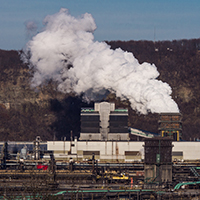
Steelmaker, Employer and Polluter
/ Julie GrantView the page for this story
People who live in and around Clairton, about 15 miles south of Pittsburgh, are suing US Steel, claiming air pollution from its Clairton Coke Works has lowered property values. The Allegheny Front’s Julie Grant visited Clairton to understand how this source of good jobs could also be the cause of health and environmental problems. (07:10)

BirdNote: The Snake Bird
/ Michael SteinView the page for this story
As it snakes along just below the surface of a Louisiana bayou, you can see how the long-necked Anhinga got its nickname. BirdNote’s Michael Stein says its serrated beak make it a danger to fish. (02:00)
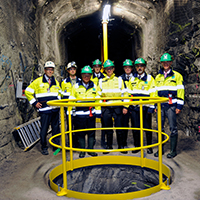
A Key to Long-Term Nuclear Waste Storage
View the page for this story
Finland is moving ahead with a system to store radioactive nuclear waste for 100,000 years, a possible example for other nuclear countries still struggling to come up with a plan. Living on Earth Host Steve Curwood spoke with Finnish nuclear policy researcher Matti Kojo and Stanford University nuclear security expert Rodney Ewing about the complexities of storing nuclear waste safely, and how community acceptance is key for success. (10:35)

Standing Bear Comes in Peace
/ Mark Seth LenderView the page for this story
Where there is sea ice, polar bears enjoy the eternal days of the Arctic summer, and one young female seems perfectly at ease – until a strange floating object across the pack ice catches her curiosity. Living on Earth’s Resident Explorer Mark Seth Lender describes her reaction to the ship and the humans who are curiously watching her. (03:35)
Show Credits and Funders
Show Transcript
HOST: Steve Curwood
GUESTS: Jim Motovalli, Brian Bienkowski, Chris Kassotis, Rodney Ewing
REPORTERS: Julie Grant, Michael Stein, Mark Seth Lender
[THEME]
CURWOOD: From Public Radio International, this is Living on Earth.
[THEME]
CURWOOD: I'm Steve Curwood. The electric car revolution is here, with car makers and car buyers scrambling to put electrons in their tanks
MOTOVALLI: By 2040 there won't be any gas or diesel cars on the road, anyway. I think we'll see the waning days of internal combustion by that point. The technology is moving very fast. I think by 2040 we'll have a totally different fleet of cars on the road.
CURWOOD: Also, when you know industrial pollution is making people sick, yet public health officials say they can't be sure.
KELLY: You've got high smoking rates. You've got old housing stock with lots of asbestos, lung cancer right there. You have low education. You have high unemployment. You have high obesity rates. All of these things are correlated with those same things.
CURWOOD: That and more, this week on Living on Earth. Stick Around.
[NEWSBREAK MUSIC: Boards Of Canada “Zoetrope” from “In A Beautiful Place Out In The Country” (Warp Records 2000)]
[THEME]
Top Gear for the Electric Car

A ‘fill-up’ for an electric car. (Photo: PROKārlis Dambrāns, Flickr CC BY 2.0)
CURWOOD: From PRI and the Jennifer and Ted Stanley Studios at the University of Massachusetts Boston, this is Living on Earth. I’m Steve Curwood.
The electric car is back. Battery vehicles dominated the market more than a century ago, and now the biggest car companies are betting they are coming back to stay. While electric and hybrid electric cars are only two percent of the market today, analysts are convinced gasoline and diesel vehicles are bound for commercial extinction in just a couple of decades or so. France says it will ban petroleum-fueled autos by 2040, and Volvo says by 2019 any newly designed models it sells will be electric or hybrid. GM already has an inexpensive electric car that will go more than 200 miles on a single charge, and this month Tesla starts selling its version of a more affordable electric with similar range.
Well, for an update on the electric car industry and its impact on self-driving cars and global warming, we’re joined by CarTalk blogger and green transportation reporter Jim Motavalli. Welcome back to Living on Earth, Jim.
MOTAVALLI: Great to be on.
CURWOOD: So, France has set this goal to, well, effectively ban petroleum vehicles by 2040. How realistic is that?
MOTAVALLI: I think it's very realistic, and I think by 2040 there won't be any gas or diesel cars on the road anyway. I think the technology’s moving very fast, that we will see the waning days of internal combustion by that point, so the ban probably will be fairly insignificant. It’ll be like banning horses or something like that. [LAUGHS] I think by 2040, we will have a totally different fleet of cars on the road.
CURWOOD: So, the other day Volvo said that all of their new cars starting in 2019 will be at least be partly electric. They’ll be hybrid or full electric. What exactly does that mean, and how smart of a business decision do you think this?
MOTAVALLI: There's been a little bit of a misconception about this announcement because the company will still be making gas cars after 2019. Effectively they will not be making any new models or introducing any new models that are gasoline or diesel-only after that point, and I think it's a very smart business move. I think it's a great idea, but the company was already moving in that direction. They started making cars that only had four cylinder engines. They're reducing the amount of gas that the cars use. They've gone to the policy of introducing hybrid and plug-in hybrid models for every vehicle in their fleet, so it's not a huge leap from where they were to where they say they're going to be in 2019, and I think it also has to do with who owns Volvo, the Chinese company Geely which is very bullish on electric cars -- and the Chinese government and the Chinese auto market in general are also very bullish on electric cars. There's dozens of automakers building them now, and the Chinese government wants the auto fleet to go in that direction largely because of horrendous auto pollution in China's cities.

A Volvo V60 Plug-In Hybrid. (Photo: John Stefou, Flickr CC BY-NC-ND 2.0)
CURWOOD: Now, there is this study from Bloomberg New Energy Finance that suggests that the price of electric cars is falling rapidly and, in fact, will be able to compete cost-wise with traditional gasoline powered cars say by sometime in the decade. What do you think is behind this plummeting in the cost of electric cars?
MOTAVALLI: Well, the cost of battery vehicles is almost entirely based on the high cost of batteries, and that was a big barrier up until where we are now. But today battery costs are falling very rapidly. It's like Moore's law for electric vehicle batteries, and Bloomberg has said that 54 percent of new car sales and 30 percent of the global auto fleet will be electric by 2040, and, at that point, China, the US and Europe will make up more than half the global market. This is despite the fact that, right now, what's selling is big SUVs and crossovers, but every automaker has plans for electric vehicles, hydrogen vehicles, plug-in hybrids, and hybrids, and I think that by 2040 most cars will be fully autonomous.
CURWOOD: And yet today people are buying our gas guzzling cars in this country?
MOTAVALLI: Yeah, people are buying gas guzzlers, but I don't think that will continue. The gas prices are pretty low right now, and that's a huge determining factor. When gas prices were high, people were abandoning their big SUVs and their Equinoxes or whatever, and they were buying hybrids. But now they say the sales of the Prius is really down right now because of cheap gas prices.
CURWOOD: Talk to me about the advancements in battery technology in terms of their quality. How good are they? How cheap are they? What's changing? What's going on with batteries in this electric car push?
MOTAVALLI: The lithium-ion batteries we use today are pretty much descendents of the lead acid batteries in our cars now. They're more sophisticated versions of that, and they use a liquid electrolyte to move the electricity because we all know that electricity moves very quickly through liquid, including water. You don't want to drop your radio in the bathtub. [LAUGHTER]

The Tesla Model 3 Electric Car. (Photo: Automotive Rhythms, Flickr CC BY-NC-ND 2.0)
So if you can make that same electricity go through a solid material, then you have a solid state battery that's cheaper or easier to move and can store more energy, and we just heard about such a break through from a 94-year-old Texas researcher name John Goodenough. He says that he can build cheap batteries that will store five to 10 times the amount of electricity as the batteries we're using in electric cars today, and he's pretty confident about it.
Other people are skeptical that this technology will work. I'd like to hope that it works, but other people are working on solid-state battery technology also, and it would be a big breakthrough if it happens.
CURWOOD: Jim, the last time we spoke, Tesla had just announced its budget electric car, the Model 3 priced at $35,000 instead of $75,000 and $105,000 like their other vehicles, and the first ones are supposed to reach consumers later this month here, in July of 2017. What's the capacity of the Model 3 to revolutionize the way that car customers think about electric vehicles?
MOTAVALLI: Well, the Model 3 has created excitement like no other car and you can go back to... when Ford came out with the model A several years after the model T. That generated a lot of excitement, but I'm not sure there were 300,000 advance orders for it, and there is that for the Model 3, and people are just very excited about it. It's an affordable electric car that will have long range, 200 miles or more and also very fast and have all the latest infotainment technology, all that kind of stuff.
CURWOOD: Right now, you can go to a General Motors car for the same money or even less, and it has the same range. Why aren't people lined up to buy those cars?
MOTAVALLI: I think they should be lined up to buy the Chevy Bolt because I think it's a very, very good car, and it does have much of the same capacity that the Model 3 will have. It’s just that Chevrolet and Tesla are not equal brand names. Tesla is, I think, until recently it was worth more than General Motors in terms of the stock evaluation, but people love the idea of being able to buy an affordable Tesla.
CURWOOD: So, talk to me about government incentives both here in the United States and elsewhere. What role do you think they will play in the future of the electric vehicle market?
MOTAVALLI: Well, I think pretty soon they will be irrelevant. Right now, they're important because you got a $7,500 federal tax credit if you buy an all-electric car battery car. You can get less for plug-in hybrid, but this is because electric cars are pricey right now, but as we move forward, as batteries get cheaper, that won't be the case anymore, and they won't need the incentives. It's possible that the Trump administration could even reduce or eliminate those subsidies. There are a lot of things that could happen to those incentives.

Evening traffic on the streets of Paris, France. (Photo: Nelson Minar, Flickr CC BY-SA 2.0)
Right now states are also offering incentives of $3,000 in Connecticut. Massachusetts has a good one. I live in Connecticut, that has a pretty good incentive right now, $3,500, and those are better than tax credits cause they are like rebates. You get the money upfront. So, right now I could buy a Chevy Bolt for like $25,000, and it would be a loaded car with all kinds of bells and whistles because automakers are trying to make their electric cars look attractive, so they have the highest option packages. They have the best stereo systems. They have the nicest seats. Right now, if you buy something like the Toyota Prius plug-in, that is an extremely nice offer that you can get from Toyota and they want to sell more of them. Right now with cheap gas, it is hard to sell electric cars, and that's why they’re such a bargain for consumers right now.
CURWOOD: So, if this predicted shift to electric cars does happen in the big way that you're talking about, how much would this help us limit global warming? You know this one-and-a-half, two degrees target from the Paris climate deal and others talk about?
MOTAVALLI: You know, it's funny because I think the main reason we are not wildly out of compliance in meeting our global warming targets is because we switched largely from coal to natural gas, and, again, I think if the Trump administration wants to encourage other forms of fossil fuels like that, I think it’s sort of running uphill against the marketplace because we've switched largely to natural gas. It is cheaper than coal and easier to use, and it pollutes a whole lot less, so I think we're seeing big advantages in terms of global warming from that. That said, I’d say the transportation system, maybe it’s 30 percent of global warming, and I think we're moving people as much as possible into public transit. Young people are deciding they want live in cities - My own kids are like that - and they may not need cars. So, we're reducing our transportation footprint anyway.
CURWOOD: Jim Motavalli blogs for NPR's Car Talk, and he's a freelance environmental journalist. Jim, thanks so much for driving the story forward.
MOTAVALLI: Great. Thanks for having me on.
Related links:
- Washington Post: “Starting in 2019, Volvo will use electricity to power every new model”
- Bloomberg New Energy Finance: Forecast for the Electric Car
- Tesla: About Model 3
- Jim Motavalli Website
[MUSIC: Hugo Montenegro and Orchestra, “Surrey with the Fringe on Top” on Overture: American Musical Theatre, volume 2, 1935-1945, composed by Richard Rodgers & Oscar Hammerstein II, Time Records]
CURWOOD: Coming up – What makes those dust bunnies under your bed dangerous. Keep listening Living on Earth.
ANNOUNCER: Support for Living on Earth comes from the Gordon and Betty Moore Foundation, and from a friend of Sailors for the Sea, working with boaters to restore ocean health.
[CUTAWAY MUSIC: Childsplay: Fiddles, Fiddler, and Fiddlemaker, “Queen Maeve’s Slumber” on Waiting For the Dawn, Sheila Falls-Keohane/arr.John McGann, Childsplay Records]
Warning About Antimicrobial Triclosan
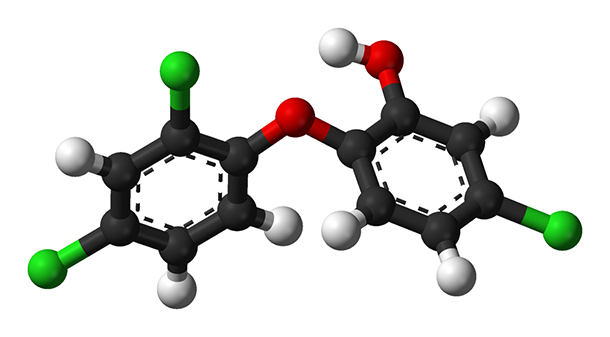
A “ball-and-stick” model of a triclosan molecule (Photo: Ben Mills, Wikimedia Commons)
CURWOOD: It’s Living on Earth. I’m Steve Curwood.
No one wants disease-causing microbes lurking on the objects around us, but over 200 scientists and health professionals are warning us about two, common, bacteria-killing ingredients called triclosan and triclocarban, found in everything from hand soaps and personal care products to furniture. Warnings about the toxicity of antimicrobials aren’t new, but this statement, published in the journal Environmental Health Perspectives, is the first to summarize findings on the adverse effects of triclosan and triclocarban. The declaration arrives as the Environmental Protection Agency is making final revisions to the Toxics Substances Control Act that Congress approved in 2016.
Brian Bienkowski, editor of Environmental Health News joins us now from Michigan with more on the story. Welcome Brian!
BIENKOWSKI: Thanks for having me, Steve.
CURWOOD: So, first, what kinds of products are triclosan and triclocarbon used in?
BIENKOWSKI: So, they're used in thousands of products, mostly personal care products and cosmetics, but they're also found in some building products, where fungi and other things can chip away at building products, and carpets and some clothing. It's currently used in Colgate Total toothpaste, which you and I can buy at the store. So they are really found everywhere, Steve.
CURWOOD: So, what are the health impacts of this? Why are folks so worried about exposure to these chemicals?
BIENKOWSKI: Scientists have found that some animal exposures have led to hormone disruption, whether it's the estrogen hormone or the thyroid hormone, and these types of hormone changes can lead to developmental problems and behavioral impacts, reproductive impacts, and we're not sure if the same things are going on in humans, but some associations have been found.
CURWOOD: So, tell me a little bit more about the statement that these 200 scientists and health care folk have signed. How did this all come together?
BIENKOWSKI: It's really a warning shot from health professionals and scientists. It's not calling for an outright ban, but it's warning consumers and manufacturers and policy makers that maybe we should pump the brakes a little bit in putting these in so many products since they haven't completely demonstrated to be safe for long-term use for humans and may not be providing the benefits that the products say that there are.
CURWOOD: What products does industry say that triclosan and triclocarban are really essential and important for, even if there is some risk?
BIENKOWSKI: In hospital settings as well as in some oral care, but even the scientists and health professionals that signed the statement agree that it should be used perhaps in some settings where people need to wash their hands before surgery and other medical procedures, or if there are people with immune system problems, being around them, it's probably good to use these products, and as I mentioned in oral care, people that have gum disease. Triclosan may provide some benefit according to some studies.

Triclosan and triclocarbon are in thousands of products from building materials to toothpaste. (Photo: Bill Branson, Wikimedia Commons)
CURWOOD: And what are the uses of these chemicals that these concerned folks say is gratuitous? Why take the risks of triclosan and triclocarbon, when there are alternatives?
BIENKOWSKI: One of those uses is hand soap at our homes or in restaurants and settings like that. It's just not demonstrated to be any more useful than water and soap, and the FDA agreed with this and is working with manufacturers to phase out triclosan from hand soaps this year.
CURWOOD: Brian, you also reported on how triclosan levels are rising in young people, in kids. Why is that happening, and what are the amounts that the researchers are seeing?
BIENKOWSKI: So, they saw spikes after children. As they age, they would see the spikes, and the hypothesis is that children are starting to wash their hands more, brush their teeth more, and just basically you're using more of these hygiene products as you age so naturally your levels will spike, and they found by the age of eight that their levels were about the same as their mothers were when they were pregnant with these children.
CURWOOD: So, if triclosan and triclocarbon can disrupt the hormone system, what are the risks the kids are running, if they are being exposed to these elevated levels of triclosan?
BIENKOWSKI: So, with any endocrine disrupting chemical, you can't test them on humans. It would be wildly unethical. So, they're largely relying on animal studies right now, but, having said that, if there are indeed impacts of the human hormone system, this can cause problems in the reproductive system, basic neurological development, brain development for children, and there has been some links between the mother's triclosan level that can cross the placenta into the womb, and children being born with smaller heads, lower birth weights, and things like that. They can't totally point to that on the triclosan use, but there have associations.

The USGS found triclosan and triclocarbon in 60% of US waterways. (Photo: Christian Ferrer, Wikimedia Commons)
CURWOOD: By the way, what is the environmental impact, if any, of these chemicals?
BIENKOWSKI: They get into waterways because after we wash our hands, these goes into our wastewater treatment plants. They get into sewage sludge that can be applied to land that runs off into the water, so USGS a few years found that triclosan and triclocarbon were in roughly 60 percent of our nation's waterways, and this can get into aquatic organisms, and it's toxic to both anything from crustaceans to fish at certain levels.
CURWOOD: So, what exactly are the scientists who signed the statement, what do they want?
BIENKOWSKI: They want this to get to the hands of people who make decisions as well as people like you and me who go to the store and perhaps look at ingredients on products because ultimately, as we've seen with chemicals like BPA, consumers can drive change. Now, the risk with that change is often these chemicals are replaced with other chemicals that have very similar properties that may also disrupt the hormone system.
CURWOOD: Yeah, how unusual is it for a couple of hundred scientists and health care workers to step forward and make a statement about a substance like this?
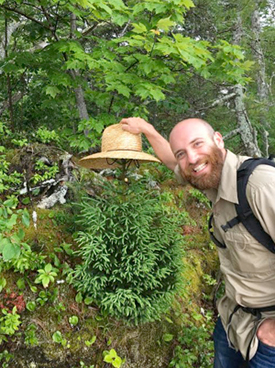
Brian Bienkowski is the editor at Environmental Health News. (Photo: courtesy of Brian Bienkowski)
BIENKOWSKI: These substances fall in this category of compounds that don't kill us, so you're looking at things like mercury and lead, and for years, we've always looked at these chemicals as the more that gets in us, the worse, and we can die. These triclosan and triclocarbon and BPA, and a lot of these endocrine disrupting chemicals are alarming scientists like this because they may hurt us at much smaller doses. Our exposures are continuous and throughout the day and throughout the month, so there are increasingly academic scientists and health professionals ringing the alarm on these endocrine disruptors because our current regulations and our current testing at the federal level doesn't fully account for these types of chemicals and the different types of toxicity that we're not accustomed to.
CURWOOD: What difference do you think this letter might make?
BIENKOWSKI: The people I talked to that signed it…A lot of them were skeptical that the Trump administration would make any changes because they've largely focused on rolling back a lot of environmental protections and regulations. So, they're not really looking there right now, Steve, but they are looking to consumers to make changes with their pocketbooks.
CURWOOD: Brian Bienkowski is the editor of Environmental Health News. Brian, thanks so much for taking the time to talk with us today.
BIENKOWSKI: Thanks for having me, Steve.
Related links:
- Beyond Pesticides advocacy group: Triclosan Information
- FDA Triclosan Review
- Nature: “Too Much Triclosan?”
Obesity and House Dust
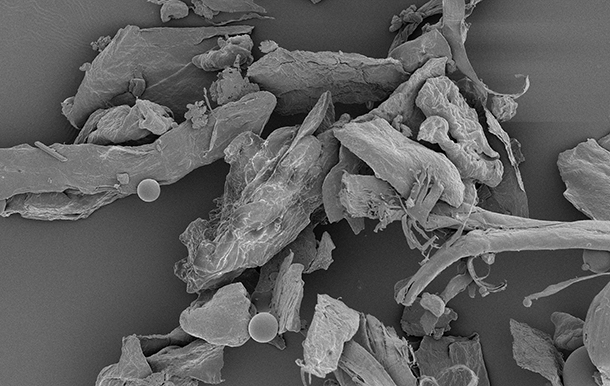
House dust under high magnification. (Photo: NIAID, Flickr CC BY 2.0)
CURWOOD: All that house dust that seems to lurk in the corners of our homes, particularly under the beds might not worry you too much, unless you’re a stickler for spotless surfaces. But new research from Duke University might have you reaching for the vacuum because what’s in that dust is hardly benign, and the irony is cleaning products like triclosan are part of the problem. Chris Kassotis, a postdoctoral research fellow at Duke’s Nicholas School for the Environment, discovered the dust contains traces of hormone disrupting chemicals such as triclosan. And in his experiments ordinary house dust spurred the growth of fat cells in a lab dish. Many common products -- plastics, flame retardants, and pesticides as well as triclosan -- are known to affect hormones, as well as neurological, reproductive, and immune functions.
Chris Kassotis co-authored the study published in the journal Environmental Science and Technology. Welcome to Living on Earth, Chris.
KASSOTIS: Hi. Thanks for having me.
CURWOOD: Chris, I was just amazed to see that your study says, essentially, I could be getting fat because I'm exposed to household dust, and the last time I looked, well, my housekeeping isn't perfect. There is dust there. How did you come to the notion that, wow, household dust could be making people fat?
KASSOTIS: Yes, it's a great question, and it's an important point. So, we definitely are not saying that house dust will make people fat. This is a preliminary step in that pathway. So, first, we're showing that house dust can stimulate the development of fat cells in the lab.
CURWOOD: But, wait a second. Doesn't that raise the specter that, at the end of the day, that therefore it could be making me fat?
KASSOTIS: So, it is testing that mechanism; however, it's a little too early to say that it would act the same way in an animal or ultimately in a human.
CURWOOD: So, talk to me some about the methodology of this study and describe what you did to test how these dust samples, in fact, seemed to simulate fat cells.
KASSOTIS: So, yes, in this study we used a mouse fat cell line. So, these are essentially fat precursor cells. If we think about the development of any differentiated or final cell type, like a bone cell or a fat cell in the body, these are fully developed cells. So, this cell model is cells that are committed to become fat cells at some point in time. They can't develop into any other cell type at this point, but, without some sort of further push, they're going to sit in their early state and not take on the characteristics of what we think of as a mature fat cell.
However, if they get that push, which we can give them by exposing them to some of these environmental contaminants, over the course of two weeks in the lab they then undergo a series of changes. So, they become more spherical in shape, and they start to accumulate lipid into the cell. Ultimately what we do is, we measure the lipid content of these cells, and then we also measure the number of these cells, and we found that these various contaminants can both increase the lipid content, we would think of this is a rough proxy for fat cell size, and they can also increase the number of cells which can create a larger pool for recruiting mature fat cells.
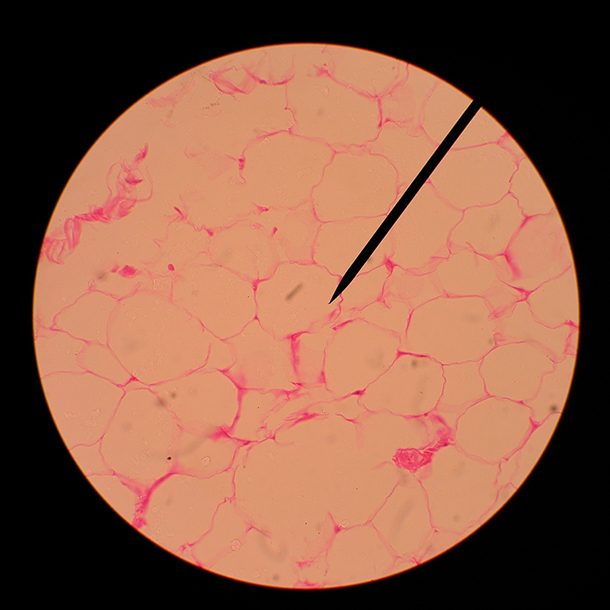
Adipose tissue containing fat cells. (Photo: RachelHermosillo, Flickr CC BY-NC 2.0)
CURWOOD: Larger, rounder...sounds like fat. [LAUGHS] Sounds fatty, anyway. How big a deal is your study? What's the breakthrough here?
KASSOTIS: So, I think the interesting thing for me is that exposure to an environmentally relevant mixture, which is house dust at very low levels, caused the development of fat cells in the lab, and, when I say very low levels, what we're talking about is the Environmental Protection Agency estimates that a child consumes about 50 mg of dust per day which is a very small amount, but the level of dust that spurred fat cell development in our study was 10,000 times lower than that. So, while there isn't a direct translation from a concentration that we use in this model to a dose that a child eats, the magnitude of that difference is concerning to us.
CURWOOD: Chris, you've got me scared. I mean, if I don't run the HEPA vacuum cleaner at my house, and a very young person comes through, it sounds like I could very well be putting them at risk of a lifetime of obesity. You don't know that yet, but that's the suspicion.
KASSOTIS: So, I will say that there are still a lot of gaps in our understanding of this topic, and there isn't a good understanding at this moment as to what level of exposure to a certain chemical results in a health effect. So, it's far too early to say that, you know, someone visiting your house would receive exposure to a chemical, and that would result in some sort of health effect.
What we normally tell people is, if you're concerned, there's plenty of steps that can be taken to reduce exposure to these chemicals. So, one of the things that we often tell people is that dusting frequently is a good way to reduce exposure. With that said, we suspect that dry dusting may just actually kick these chemicals back up in the air and make it easier to inhale them. So, it really should be a wet dusting to avoid increasing your exposure to these chemicals.
CURWOOD: So, a fat kid might say, “It's not my fault. It's not the soft drinks or the potato chips. It is the fact that my parents, well, they didn't clean the house as often as they might have.”
KASSOTIS: Well, ultimately we don't know enough to say whether that's going to be a contributory factor in humans, certainly. What I can say is that we do have some compelling studies in animals where they have exposed an animal during gestation. So, while they're still in the mother and then controlled for food intake and controlled for exercise and monitored weight gain, and the animals exposed to the chemical gained more weight than the animals that weren't, suggesting that it's not just about exercise, and it’s not just about the amount of food you eat. The exposure to that chemical may have reprogrammed your metabolism in some way, such that your body handles nutrients and calories differently than other people or other animals because that work has all been done with animals.

Chris Kassotis is a researcher at Duke University. (Photo: courtesy of Chris Kassotis)
CURWOOD: So, what comes next in terms of this research?
KASSOTIS: So, I think two things stand out to me. The first is seeing if rodents, you know mice or rats exposed to house dust probably via their diet, in some way show some sort of metabolic risk or disruption, whether that's weight gain or some other outcome that we can measure. The second thing is looking for an association with humans. So, that's going to take a larger study with a lot more house dust, and we commonly talk about children being the most sensitive to exposures of this type, so it may be you really have to look at young adults or children and their metabolic health to find any sort of connection.
CURWOOD: Chris Kassotis is a postdoc research fellow at the Nicholas School for the Environment at Duke University. Chris, thanks so much for taking the time today.
KASSOTIS: Thanks so much for your interest.
Related links:
- Environmental Science & Technology: The study on house dust and fat cell growth
- NBC: More Evidence Chemicals Linked to Obesity and Diabetes
- About Chris Kassotis
Steelmaker, Employer and Polluter

Clairton Coke Works. While the large white plume is mostly water vapor, the plant is a significant source of harmful air pollution. (Photo: Mark Dixon, Flickr CC BY 2.0)
CURWOOD: Indoor dust poses one set of risks while tiny particles and acid-forming chemicals from industry can affect the air of an entire town or region. So people who live and breathe in and around Clairton, about 15 miles south of Pittsburgh, are suing US Steel. The class action lawsuit claims air pollution from the company’s Clairton Coke Works has lowered property values. Not so long ago, the coke plant was seen as a source of good jobs and prosperity, but as awareness of the health effects of pollution grows, attitudes are changing, as Julie Grant of the program Allegheny Front discovered.
GRANT: The US Steel Clairton Coke Works is in Richard Ford’s blood. He joined the rest of his family, and worked there as a young man.
FORD: My grandfather, both my grandfathers, worked in the mill, my father worked at the mill, my wife worked at the mill, my brother worked at the mill, his wife worked in the mill, my uncle worked in the mill, two uncles worked in the mill…
GRANT: You get the picture. And in this lower income community, those have been good jobs. Ford remembers 10 or 15 years ago, people from nearby wealthier communities, Mount Lebanon and Upper St. Clair, came to Clairton to talk about pollution from the mill.
FORD: We ran them outta here. Because the mill was the best job in town. We said, “How are you going to tell us? We live here. You go to Upper St. Clair and keep living like you’re living, and we’re going to stay right here.” And this was the argument I’m telling you we had, as long as there’s smoke coming from the mills, we’re eating, we’re drinking, and we’re driving good. We’re sending kids to college. We thought that was alright.
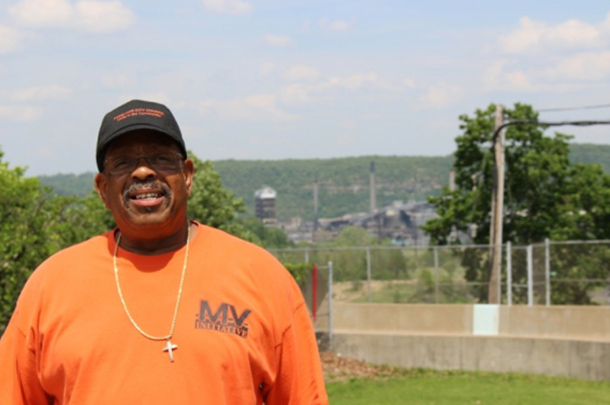
Just about every member of Richard Ford’s family has worked at Clairton Coke Works, and three members of his immediate family have died prematurely from disease. (Photo: Julie Grant)
GRANT: They knew the mill was causing pollution. Making coke is dirty business. The plant brings in coal, burns it at high temperatures, and then quenches it with water. You can see the steam this creates blowing out of quench towers into the air. People here are used to the stench, and the heavy cloud of pollution that can hang over the Mon Valley. And Ford can still picture hanging white sheets on the clothes line as a kid. By the time they dried, the sheets would be grey.
FORD: Our parents would hit a broom on it, and all the stuff would drop off of it. You could literally see it. And the sheets were white.
GRANT: Air quality has improved since Ford’s childhood. US Steel spent a half-billion dollars to replace one of its old coke oven batteries, with environmentally friendlier technology, as well as new quench towers, and other upgrades. And while there are still many concerns about the plant’s pollution, Ford, who is a now member of Clairton city council, says people have long depended on those jobs, and the schools on the tax money that comes from US Steel. But he’s been starting to wonder if the costs of the mill are still too high for Clairton.
FORD: In my own family, my dad died of cancer of the trachea. I had daughter that died at the age of 25 with scleroderma. My son passed away this past October with prostate cancer.
GRANT: Others I spoke with here offer similar lists, family members who are sick, or died of cancers and other diseases. And Ford says they’re starting to look at the coke plant with new eyes.
FORD: It’s an awareness now that’s just sparked in us. And we’re ready to listen now, and try to do something about it because it’s so apparent to us.
GRANT: Some people living near the plant have just filed a class action lawsuit, claiming the pollution has lowered their property values. But can Clairton and other communities in the path of plant’s emissions really prove that their health problems are caused by US Steel’s coke plant?
KELLY: Well, that’s exceptionally difficult to do.
GRANT: Jim Kelly is deputy director of Environmental Health at the Allegheny County Health Department. Clairton Coke Works violated its air permit 6700 times between 2012 and 2015. Kelly says the Health Department reached a new consent decree with US Steel to reduce pollution last year. And yet, the Mon Valley still does not meet federal air quality standards for sulfur dioxide and fine particulate matter. Those pollutants can cause lung problems and other health issues. A new countywide survey released by the health department finds that cancer rates in Clairton are slightly higher than the county as a whole. But the plant’s emissions blow toward Braddock, a small community with its own US Steel facility. Cancer rates there are double the rest of the county. But, Kelly says, it’s not easy to pin diseases on US Steel. There are so many reasons people get cancer, especially in low income areas.

Children in Clairton are three times more likely to have asthma than kids nationwide. (Photo: Julie Grant)
KELLY: You’ve got high smoking rates. You’ve got old housing stock, with lots of asbestos, lung cancer right there. You have low education. You have high unemployment. You have high obesity rates. All of these things are correlated with those same things.
GRANT: Researchers around Pittsburgh are trying to tease out the role air pollution plays in cancers and other diseases. One new study finds that underprivileged children in Clairton, and other Allegheny County communities near smokestacks, are twice as likely as other children in the region to have asthma. Clairton’s kids are three times more likely to have asthma than kids nationwide.
DOUGHERTY: Some day when the air quality is really, really bad, I would like someone to go into any first grade, anywhere, and say, “We’re going to take your kids on a field trip to US Steel.”
GRANT: Shelly Dougherty recently moved to Jefferson Hills, right on the border of Clairton, two miles from the plant. She wasn’t happy when she noticed what she calls the smell of a dirty gold fish bowl.
DOUGHERTY: And we’re going to sit them in front of the steel mill for eight hours and let them breathe in that air. And I want to see how many parents would say, “Sure, let’s bring our kids down there to breathe that air.”
GRANT: Why would we do that?
DOUGHERTY: Then why should the children of Clairton have to do it every day?
GRANT: I met Doughterty because she agreed to work with researchers at Carnegie Mellon University. They came out and put an air quality monitor on her house. She heard about the project on Clairton’s Facebook page. And I should mention that Shelly is not her real name. She asked us not to use it because she got some nasty comments when corresponding on the site about air quality in the area.
DOUGHERTY: What he said was, something to the effect of, “F-U, we need our jobs.” So, yeah, I took the post right down because I didn’t know who this person was.
GRANT: So you were scared?
DOUGHERTY: Well, yeah, because that’s the way it is out here. It’s one of two ways. People either feel like I do, or they look at people like me, like, you’re trying to take our jobs. And that’s not the case at all. No one wants to take away anyone’s jobs. All we want is for US Steel to abide by regulations.

It is difficult for Clairton community members to prove that their health problems were caused by pollution from the US Steel Coke Plant. (Photo: Gene Daniels, Wikimedia Commons)
GRANT: We contacted US Steel for this story but didn’t hear back. The local Steelworkers Union says they’re not concerned about the Clairton Coke Works closing down. They’re currently hiring. And the Allegheny County Health Department says they’re working on a plan for the Mon Valley to meet Clean Air Act requirements by October. If the region doesn’t meet those standards within a year, the federal government will take over. I’m Julie Grant.
CURWOOD: Julie reports for the public radio program, the Allegheny Front.
Related links:
- Pittsburgh Quarterly: “The Region’s Top 10 Air Polluters”
- 2015-2016 Allegheny County Health Survey
- PennEnvironment Air Pollution Report, “Toxic Ten”
- Pittsburgh Post-Gazette: “Asthma at ‘epidemic’ levels in region’s schools, experts say on World Asthma Day”
- Clean Air Council: Pittsburgh Air Pollution
BirdNote: The Snake Bird

A Snakebird, or Anhinga, snaking along in a Louisiana bayou. (Photo: Mike Hamilton)
[MUSIC: BIRDNOTE® THEME]
CURWOOD: We head now into the steamy wilderness of a Louisiana bayou, where, as Michael Stein explains in today’s Birdnote, some birds can be, well, downright weird.
BirdNote®
Anhingas — Snakebirds!
[Bayou sounds from http://birdnote.org/show/morning-bayou]
Spanish moss hangs eerily from cypress trees rising from the black water of a Louisiana bayou. The water ripples where a slender form glides just beneath the surface. At first glance, it appears to be a snake. But look closer, and you just might see a long, narrow spike of a beak at the tip of a slender neck. It’s a Snakebird, a colloquial name for the Anhinga, swimming with just its head and neck above the water.
[Anhinga call, https://macaulaylibrary.org/audio/136256, 0.06-.08]
Anhingas belong to a small group of birds called the darters, and they look a bit like cormorants.
[Anhinga call, https://macaulaylibrary.org/audio/136256, 0.06-.08]

Anhinga drying off. (Photo: Mike Hamilton)
When hunting fish, an Anhinga hangs motionless in the water or swims slowly just below the surface, its neck crooked, almost like a cobra’s. The Anhinga has specialized muscles and a hinge in its neck. And when an unwary fish swims close, the bird’s head darts forward, impaling its prey.
Backward slanted serrations keep the fish from slipping off.
Surfacing with its beak held just slightly open, the bird flicks the fish upward and catches it in mid-air. Then it downs it headfirst.
And, once again, the Anhinga glides through the black water. I’m Michael Stein.
[Bayou sounds from http://birdnote.org/show/morning-bayou]
###
Written by Bob Sundstrom
Bird sounds provided by The Macaulay Library of Natural Sounds at the Cornell Lab of Ornithology, Ithaca, New York. 136256 recorded by Martha J. Fischer.
Producer: John Kessler
Managing Producer: Jason Saul
Associate Producer: Ellen Blackstone
© 2017 Tune In to Nature.org July 2017 Narrator: Michael Stein
Related links:
- The story on the BirdNote website
- Learn more about the Anhinga, or Snakebird, from the Cornell Lab of Ornithology
[MUSIC: Dr. John, “Right Place Wrong Time” on In the Right Place, Atco Records]
CURWOOD: Coming up, a small nation becomes a big player in the quest for permanent storage of nuclear power waste. That’s just ahead here on Living on Earth. Stay tuned.
ANNOUNCER: Funding for Living on Earth comes from you our listeners, and United Technologies - combining passion for science with engineering to create solutions designed for sustainability in the aerospace, food refrigeration and building industries. UTC companies such as Otis, Carrier, Pratt & Whitney and UTC Aerospace Systems are helping to move the world forward.
This is PRI, Public Radio International.
[CUTAWAY MUSIC: New Black Eagle Jazz Band, “Tight Like This” on At the Potomac River Jazz Club, composed by Louis Armstrong, Black Eagle Records]
A Key to Long-Term Nuclear Waste Storage
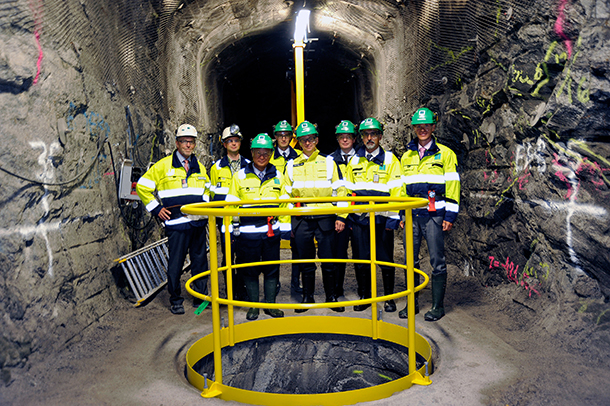
IAEA Director General Yukiya Amano tours the Onkalo nuclear waste repository during his official visit to Olkiluoto, Finland in 2012. (Photo: IAEA Imagebank, Flickr CC BY-SA 2.0)
CURWOOD: It’s Living on Earth. I’m Steve Curwood.
Seven decades into the age of nuclear power, the United States has yet to solve the problem of waste. Brand new uranium fuel is only slightly radioactive and easily handled. But when uranium is “burned’ in a power reactor the waste by-products, including strontium, cesium and plutonium can be a million times more radioactive than uranium—and one kind of plutonium is too hot to handle without protection for at least 250,000 years. And while the US debates what to do with nuclear power waste, Finland says it has found an answer, and plans to build one of the world’s first long term nuclear waste storage facilities in a labyrinth of underground tunnels. The Onkalo Nuclear Waste Repository is planned on an island off the west coast of Finland, and nuclear policy researcher Matti Kogo says that, once they bury the waste in the tunnels, not much else will need to be done.
KOJO: The idea is to, well, the idea is to more or less forget it. It’s based on passive safety. There aren’t any plans to put any kind of warning signs or anything like that. There won’t be anything.
CURWOOD: The plan is for Onkalo to store the radioactive waste for 100,000 years. In America, there is broad opposition to using Yucca Mountain in Nevada for long term storage of spent nuclear fuel, but the project in Finland has widespread support. Matti Kogo explains that the Finns have many reasons to be keen about opening the door to nuclear waste storage development.
KOJO: The local community has quite a close relationship with the nuclear industry. There are local people working at the nuclear power plant and the municipality is also dependent on the tax income coming from the company. So, we could say that the local community tolerates the waste. In the Finnish culture, in the Finnish society, there is quite high trust on authorities and scientists, and in this case, there is a lot of trust towards the safety regulator.
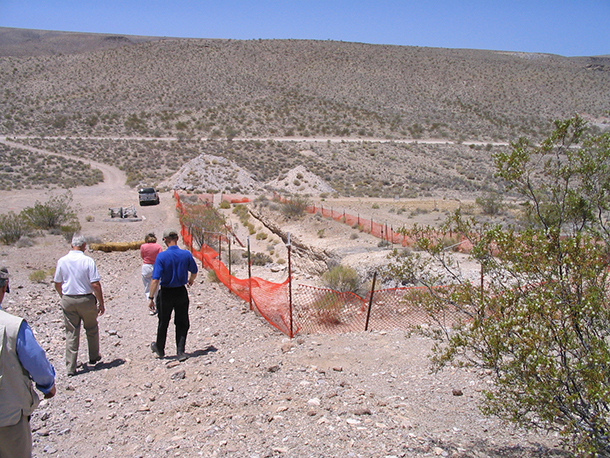
Nuclear Regulatory Commission (NRC) staff visiting the proposed high-level waste repository site at Yucca Mountain, Nevada. (Photo: Nuclear Regulatory Commission, Flickr CC BY-NC-ND 2.0)
CURWOOD: Temporary nuclear waste stores around the world are filling rapidly and, despite local opposition to using Yucca Mountain for a permanent site, President Trump has proposed spending $120 million to continue working there. Stanford University Professor of Nuclear Security and Environmental Studies Rodney Ewing joins us now to explain the urgency behind finding a final resting place for deadly nuclear wastes. Professor Ewing, welcome to Living on Earth.
EWING: Thank you, glad to be here.
CURWOOD: So, first, let's talk a little bit of the physics of nuclear waste. What exactly is it?
EWING: When a reactor operates what you're tapping into in terms of energy is the nucleus of an atom, and you tap into that energy by splitting the atom - The process is called fission - and by splitting the atom we get a little bit of energy, actually quite a lot of energy but then we're left with the used fuel with once it's taken out of a reactor has to be cooled before it can be handled any further, and it has to be shielded because of the intense radiation field around it.
CURWOOD: Professor, when countries around the world first began embracing nuclear power, what were the plans for handling the radioactive waste that these fission reactors would generate?
EWING: Well, in fact, if we go back to the earliest days of nuclear power there's very little attention paid to the question of what to do with the waste - and this was partly, let's call it benign neglect - but part of the neglect was based on the plan or hope that this used fuel would be reprocessed.
CURWOOD: But that didn't happen. Why didn’t we do that?
EWING: Well, many reasons. First, in the United States we tried but not successfully to build such plans, but probably the fundamental reason was economics. It cost a certain amount to reclaim the fissile material. As it has turned out uranium is not as rare as we thought in the 1950s, early 1960s, and so it's much cheaper to just mine new uranium rather then reprocess. Now, one kind of footnote to this is actually for some time now, we've purchased weapons uranium from the Russians and diluted it down and that's been burned in US reactors.
CURWOOD: So, how urgent is this issue of building nuclear repositories for high-level waste around the world and in the US.
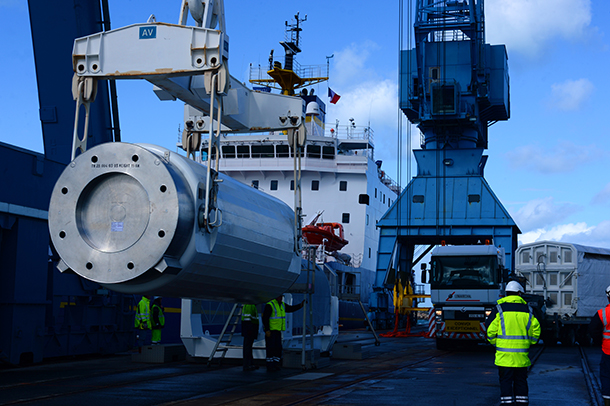
Storage of radioactive waste in most cases currently involves isolating the waste in a series of casks, but experts say this is only a short-term solution. (Photo: IEAE Imagebank, Flickr CC BY-NC-ND 2.0)
EWING: On one hand, one can look at the present state of the fuel. In the United States, the used fuel, accumulates at the reactor sites in pools and in casks, dry cask storage, at over 70 sites in 35 states in the United States. Pool storage or dry cask storage was envisioned to last for only a few decades, and so I would say if you are a community living near one of these sites, one would be anxious about the fate of this used fuel. The other perspective, let's say the engineering perspective, is that the fuel once it is in these dry casks probably can be stored in this state for many decades, some projected up to, say, 100 years. Even though that is a long time, that certainly is not an acceptable long-term solution, and the idea has always been around the world that geologic disposal can satisfy these long time periods that are required.
CURWOOD: How important is winning public acceptance and support for geological waste disposal projects? I mean, Finland has been successful with its public engagement and seems close to moving forward with a deep geologic solution currently to protect the rest of the world for 100,000 years from their radioactive waste. What are the lessons that the US or other economies could learn from what's going on in Finland.
EWING: Public engagement and acceptance is critical, and I say that based on a study conducted by the Nuclear Waste Technical Review Board which looked at the history of nuclear waste programs around the world, and what becomes clear from looking at the experience of other countries is, first, this is a very difficult job. It's very difficult to engage both the political and public elements in the process, and if we look at the countries that are moving forward such as Sweden, Finland, Canada, France, a noteworthy characteristic of all of those programs is that the company in charge of the project has a very well developed program of public engagement that stretches necessarily over decades.
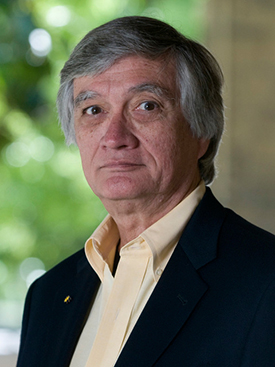
Rodney Ewing is the Frank Stanton Professor in Nuclear Security and a Professor in the Department of Geological and Environmental Sciences at Stanford University. (Photo: Stanford University)
CURWOOD: In your view, how feasible would it be to adapt the Finnish process to America?
EWING: It would be very difficult in fact for three reasons: the size of the country is very different, so the ability to communicate between the government and the people I think is more difficult in a larger country like the United States; it would be difficult because the cultures are different in terms of views about authority and scientific credibility and so on; and it would be difficult because in United States we have the state/federal government system, where in Finland and Sweden you have municipalities. And so I think one can make the object ration that you need a plan for public and political engagement. We should study how other countries have done this, but certainly with all parties involved, we need to develop our own.
CURWOOD: Now, recently the Trump administration said that it would like $120 million dollars to re-open the licensing process for Yucca Mountain, that nuclear repository there in Nevada that has been kicking around for a long time. How does Nevada measure as a nuclear disposal site?
EWING: It's very clear looking at other national programs that there are really two filters that a program has to pass through. One is a technical filter, you have to do the science and engineering properly, and the other is a social filter. Having said that, now going to Yucca Mountain, yes, there's a strong push to fund the licensing process for Yucca Mountain, but I think one can't neglect the fact the state of Nevada has been very clear about their position, which is they don't want it. This means that for the US side, we try to skip the public engagement and acceptance of the strategy. On that point alone, I'm not very optimistic about Yucca Mountain as a future repository.
CURWOOD: So, sounds to me like there just is not the political system or will right now to really solve this problem.
EWING: It's very difficult because these projects last over decades. They last for longer periods of time then any administration, and so if we want to be successful we have to design a system that can survive the fluctuations of the political sphere, and are based on public acceptance from the state on down and a sound technical strategy.
CURWOOD: Rodney Ewing is Professor of Nuclear Security and Environmental Studies at Stanford University. He's also former chair of the U.S. Nuclear Waste Technical Review Board. Professor Ewing, thanks so much for taking the time with us today.
EWING: My pleasure. Thank you.
Related links:
- Wired: “Journey deep into the Finnish caverns where nuclear waste will be buried for millennia”
- The Nuclear Regulatory Commission’s Backgrounder on Radioactive Waste
- Nuclear Regulatory Commission: Yucca Mountain background information
- Rodney Ewing Professor Profile
[MUSIC: Monty Python, “Finland, Finland, Finland” on the soundtrack to Spamalot, composed by Eric Idle and John Du Prez, Decca Broadway]
Standing Bear Comes in Peace

A female polar bear awakes from her slumber and notices the ship where Mark Seth Lender and other passengers are watching her (Photo: Mark Seth Lender)
CURWOOD: With cold places in mind, there’s news from the other end of the globe in Antarctica, where a massive iceberg that was hanging by a thread – or at least by a fragile snow bridge - to the Larsen C ice sheet has broken free, liberating a trillion tons of ice to float away in the southern ocean. When he was down there Living on Earth’s explorer in residence, Mark Seth Lender took some pictures of a fragment of another vast tabular iceberg, the size of Central Park, and over 100 feet high. You’ll see his photos at our website LOE.org and also some of a polar bear, displaying its remarkable strategic skill on the archipelago of Svalbard, inside the Arctic Circle. Polar bears often feign indifference as a hunting technique, ignoring their intended prey, and showing greater interest in something else. But sometimes, they aren’t even hunting.

The bear opens her mouth wide in an expression of surprise -- no animosity, says Mark Seth Lender. (Photo: Mark Seth Lender)
Standing Bear Comes in Peace
© 2017 Mark Seth Lender
All Rights Reserved
LENDER: The sun will not set for another 3 months to which the polar bears are indifferent. The floe edge rumbles and rolls in the swell, beneath them. As long as there is ice, everything is all right with them.
At the brink of a wide lead where the ocean is blackened by the depth, a bear spreads out like a big white sack, all size and not a lot of shape as if she fell, flat, from a headlong fall. Arms by her sides. Palms of her enormous paws turned up, each a great dipper set as if to capture rain, or snow. She yawns. Rolls onto her side, reclined like a diva on a couch. Only then does she focus on the ship resting in open water across the pack ice.
The bear is young. Her whiteness gives that away (like us polar bears yellow with age). This, and her girth, her density which is less than it will become. And her lack of scars. She is expressionless from afar, walking, in the ambling, business-like way, of polar bears. Gazing, not left or right as they usually do but only toward the ship, eyes more wide the closer that she comes.

The polar bear swims towards the ship (Photo: Mark Seth Lender)
And takes a drink from the meltwater that puddles on the ice.
And stops alongside.
And looks. Up. And up. Neck stretched out toward the strange new Animals who lean on the deck rail their forepaws dangling and all their faces turned, toward her.
The bilge pump disgorges and she startles and crossing her long arms right over left jogs sideways.
But does not run.
But only stares at…

Standing bear. (Photo: Mark Seth Lender)
This thing, the color of ice that is not ice and the bear-like creatures who are not bears standing there to look at her!
How Strange... How strange...
And rises on her enormous hind legs - to five to seven to eight feet tall - taller than a female bear is supposed to be. And stands. Mouth open in surprise and meets, the eyes, of each and every one of them.
Her lower lip juts out as polar bears do when afraid.
And down again and drinks. And drinks again.
And keeps pace.
As the ship drifts.
And the swell rolls.
And the sun burns.
And the ice melts, until Perpetual Day becomes again Perpetual Night in this place where everything is, Impermanence.
And looks…
And leaves.
Related links:
- To learn more about polar bears, visit Mark’s website
- One Ocean Expeditions
[MUSIC: Paul Barton, “Aquarium” from Le carnaval des animaux (The Carnival of the Animals) on Piano Teaching Tips: Youtube Tutorials From Paul Barton, by Tim Topham, music composed by Camille Saint-Saëns]
CURWOOD: Living on Earth is produced by the World Media Foundation. Our crew includes Naomi Arenberg, Bobby Bascomb, Savannah Christiansen, Jenni Doering, Matt Hoisch, Noble Ingram, Jaime Kaiser, Don Lyman, Lizz Malloy, Helen Palmer, Olivia Reardon, Rebecca Redelmeier, Adelaide Chen, and Jolanda Omari. Special thanks to One Ocean Expeditions. Jake Rego engineered our show, with help from John Jessoe. Alison Lirish Dean composed our themes. You can hear us anytime at LOE.org - and like us, please, on our Facebook page - PRI’s Living on Earth. And we tweet from @LivingOnEarth. I'm Steve Curwood. Thanks for listening.
ANNOUNCER1: Funding for Living on Earth comes you, our listeners, and from the University of Massachusetts, Boston, in association with its School for the Environment, developing the next generation of environmental leaders. And from the Grantham Foundation for the protection of the environment, supporting strategic communications and collaboration in solving the world’s most pressing environmental problems. Support also comes from the Energy Foundation, serving the public interest by helping to build a strong, clean, energy economy, from Carl and Judy Ferenbach of Boston, Massachusetts and from SolarCity, America’s solar power provider. SolarCity is dedicated to revolutionizing the way energy is delivered by giving customers a renewable alternative to fossil fuels. Information at 888-997-1703. That’s 888-997-1703.
ANNOUNCER2: PRI. Public Radio International.
Living on Earth wants to hear from you!
Living on Earth
62 Calef Highway, Suite 212
Lee, NH 03861
Telephone: 617-287-4121
E-mail: comments@loe.org
Newsletter [Click here]
Donate to Living on Earth!
Living on Earth is an independent media program and relies entirely on contributions from listeners and institutions supporting public service. Please donate now to preserve an independent environmental voice.
NewsletterLiving on Earth offers a weekly delivery of the show's rundown to your mailbox. Sign up for our newsletter today!
 Sailors For The Sea: Be the change you want to sea.
Sailors For The Sea: Be the change you want to sea.
 The Grantham Foundation for the Protection of the Environment: Committed to protecting and improving the health of the global environment.
The Grantham Foundation for the Protection of the Environment: Committed to protecting and improving the health of the global environment.
 Contribute to Living on Earth and receive, as our gift to you, an archival print of one of Mark Seth Lender's extraordinary wildlife photographs. Follow the link to see Mark's current collection of photographs.
Contribute to Living on Earth and receive, as our gift to you, an archival print of one of Mark Seth Lender's extraordinary wildlife photographs. Follow the link to see Mark's current collection of photographs.
 Buy a signed copy of Mark Seth Lender's book Smeagull the Seagull & support Living on Earth
Buy a signed copy of Mark Seth Lender's book Smeagull the Seagull & support Living on Earth

